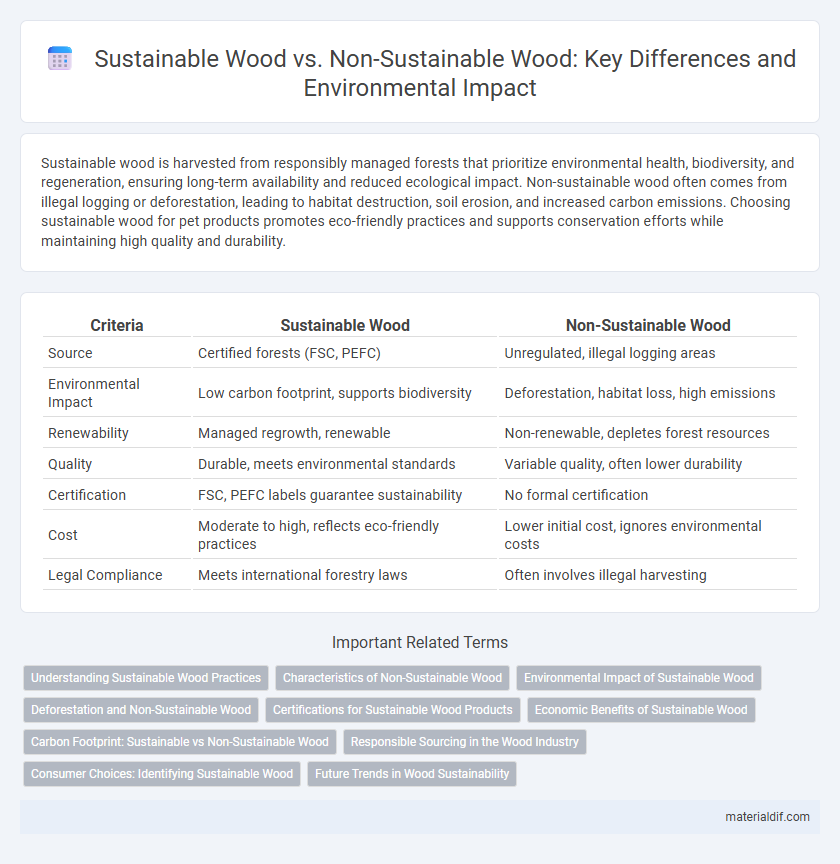Sustainable wood is harvested from responsibly managed forests that prioritize environmental health, biodiversity, and regeneration, ensuring long-term availability and reduced ecological impact. Non-sustainable wood often comes from illegal logging or deforestation, leading to habitat destruction, soil erosion, and increased carbon emissions. Choosing sustainable wood for pet products promotes eco-friendly practices and supports conservation efforts while maintaining high quality and durability.
Table of Comparison
| Criteria | Sustainable Wood | Non-Sustainable Wood |
|---|---|---|
| Source | Certified forests (FSC, PEFC) | Unregulated, illegal logging areas |
| Environmental Impact | Low carbon footprint, supports biodiversity | Deforestation, habitat loss, high emissions |
| Renewability | Managed regrowth, renewable | Non-renewable, depletes forest resources |
| Quality | Durable, meets environmental standards | Variable quality, often lower durability |
| Certification | FSC, PEFC labels guarantee sustainability | No formal certification |
| Cost | Moderate to high, reflects eco-friendly practices | Lower initial cost, ignores environmental costs |
| Legal Compliance | Meets international forestry laws | Often involves illegal harvesting |
Understanding Sustainable Wood Practices
Sustainable wood practices prioritize responsible forest management, emphasizing selective logging, reforestation, and the protection of biodiversity to ensure long-term ecosystem health. Certified forests adhering to standards like FSC (Forest Stewardship Council) and PEFC (Programme for the Endorsement of Forest Certification) promote sustainable harvesting methods that minimize environmental impact. Non-sustainable wood sources often lead to deforestation, habitat destruction, and increased carbon emissions, highlighting the importance of choosing sustainably sourced wood for environmental conservation.
Characteristics of Non-Sustainable Wood
Non-sustainable wood often comes from forests that are overharvested, resulting in habitat loss and decreased biodiversity. It typically involves illegal logging practices that contribute to soil erosion and carbon emissions. This type of wood lacks certification from organizations like FSC (Forest Stewardship Council), indicating poor environmental and social responsibility.
Environmental Impact of Sustainable Wood
Sustainable wood is harvested from responsibly managed forests that prioritize biodiversity conservation and ecosystem health, significantly reducing deforestation and habitat loss. This practice enhances carbon sequestration by maintaining forest cover, which mitigates climate change more effectively than using non-sustainable wood sourced from clear-cut or illegally logged areas. Utilizing sustainable wood supports renewable resource cycles and minimizes pollution, contributing to long-term environmental balance and reduced carbon footprints in construction and manufacturing.
Deforestation and Non-Sustainable Wood
Non-sustainable wood harvesting significantly accelerates deforestation, leading to habitat loss, biodiversity decline, and increased carbon emissions. Unsustainable logging practices often involve clear-cutting and illegal timber extraction, which disrupt ecosystems and degrade soil quality. Choosing sustainable wood sources helps preserve forests, supports carbon sequestration, and maintains ecological balance.
Certifications for Sustainable Wood Products
Sustainable wood products are certified by organizations such as the Forest Stewardship Council (FSC) and the Programme for the Endorsement of Forest Certification (PEFC), which ensure environmentally responsible forest management. These certifications verify that the wood comes from forests that maintain biodiversity, protect water resources, and support local communities. Non-sustainable wood lacks these certifications, often contributing to deforestation, habitat destruction, and increased carbon emissions.
Economic Benefits of Sustainable Wood
Sustainable wood harvesting promotes long-term economic stability by ensuring continuous forest resources and reducing costs associated with environmental damage and regulatory penalties. Markets increasingly favor certified sustainable wood products, boosting demand and providing premium pricing opportunities for businesses. Investing in sustainable wood supports local economies through job creation in responsible forestry and eco-friendly industries.
Carbon Footprint: Sustainable vs Non-Sustainable Wood
Sustainable wood production significantly reduces the carbon footprint by promoting responsible forest management, which ensures continuous carbon sequestration and minimal environmental disruption. Non-sustainable wood harvesting leads to deforestation, increased greenhouse gas emissions, and loss of biodiversity, exacerbating the carbon footprint. Using certified sustainable wood sources such as FSC or PEFC helps mitigate climate change by maintaining forest carbon stocks and supporting ecosystem resilience.
Responsible Sourcing in the Wood Industry
Sustainable wood comes from forests managed through responsible sourcing practices that ensure regeneration, biodiversity preservation, and minimal environmental impact. Non-sustainable wood often results from illegal logging, deforestation, and poor forest management, causing habitat loss and increased carbon emissions. Certification systems like FSC and PEFC help verify responsible sourcing, promoting eco-friendly practices in the global wood industry.
Consumer Choices: Identifying Sustainable Wood
Consumers prioritize sustainable wood by selecting products certified by organizations like the Forest Stewardship Council (FSC) or Programme for the Endorsement of Forest Certification (PEFC), ensuring responsible forest management and environmental protection. Sustainable wood sources minimize deforestation, support biodiversity, and reduce carbon footprints compared to non-sustainable wood, which often originates from illegal logging or poorly managed forests. Identifying sustainable wood involves verifying labels, understanding species provenance, and choosing recycled or reclaimed wood to promote ecological balance and long-term resource availability.
Future Trends in Wood Sustainability
Innovations in sustainable wood emphasize certified forestry practices and the rise of engineered wood products that reduce deforestation. Future trends highlight the integration of blockchain technology to verify wood origin and promote transparency in supply chains. Advances in biodegradable treatments and carbon sequestration methods are expected to enhance the environmental benefits of sustainable wood.
Sustainable Wood vs Non-Sustainable Wood Infographic

 materialdif.com
materialdif.com